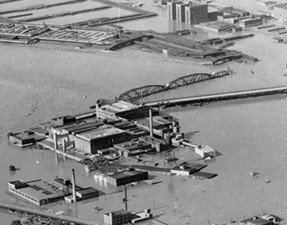August 26, 2023 *new date*
Nuestro Legado/Our Legacy Series
The Impact of Destructive Floods on the Kansas City Region
10:00 a.m. to 11:30 a.m.
$10 per person
J.E. Dunn Construction Theater, 3rd Floor
Click here to purchase your seat.
July 13, 2023 will mark the 72nd anniversary of the devastating 1951 flood, but destructive inundations caused by the Kansas and Missouri rivers have long plagued the region. The valley where the Kansas and Missouri rivers meet has always been a flood zone. In 1823 the Chouteau brothers trading post was forced to move to higher ground because of flooding. As the railroads, stockyards, and other industries arrived after the Civil War, their gradual encroachment on the riverbanks started shrinking the mouth of the Kaw River. By 1903, the width had diminished nearly by half and 17 bridges crossed the river within a four-mile span between the Argentine neighborhood and the Kaw’s mouth.
The Kansas River breached its banks on May 30, 1903, and reached a height of 14 feet above flood stage destroying 23,000 homes, 16 bridges, and all utility services. These precursors will be discussed as well as the all of the significant factors associated with the flood of 1951. KCM’s Historian in Residence, Dr. Gene T. Chávez will share video interviews he collected from 1951 Flood survivors and discuss measures taken by city authorities on both side of the Kansas and Missouri state line to prevent future flooding.
For more information, please contact Glenn North, Director of Inclusive Learning and Creative Impact at gnorth@kansascitymuseum.org

photo credit: Missouri Valley Special Collections, Kansas City Public Library, Kansas City, Missouri






